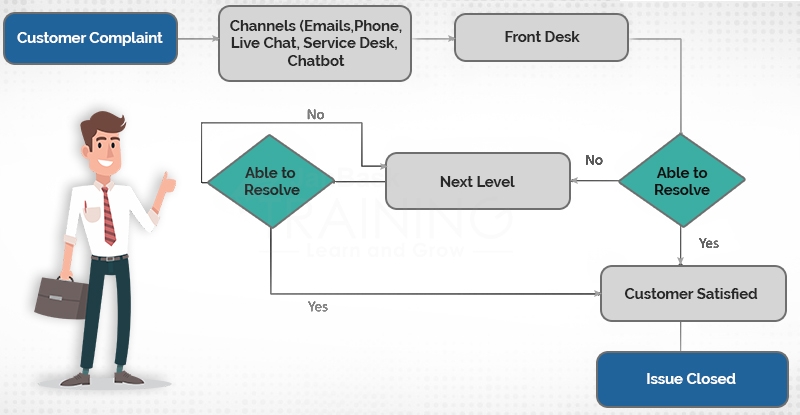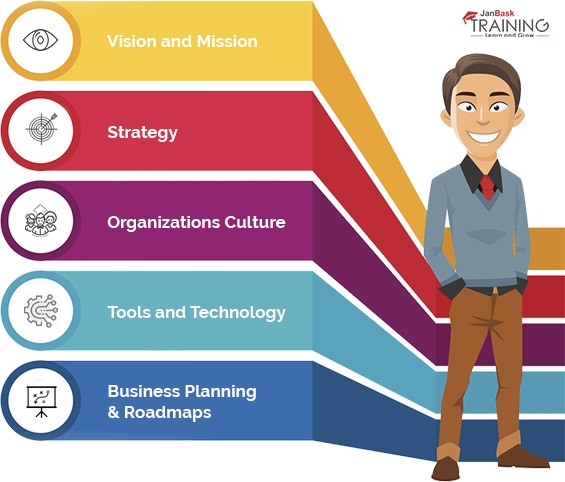11
JulInternational Womens Day : Flat 30% off on live classes + 2 free self-paced courses - SCHEDULE CALL
The way of logical thinking has broadened possible ways. It has direct impacts on the growth of your company. Every business which runs in the market has strong pillars behind it. These pillars are nothing but a strong analysis that is done. It is to make sure for a successful business and its hold over the market.
The viewpoint is to gain -
It forms a key concept for calculative analysis. It helps to improve the performance, quality, and future of a business. These are derived from various contributors. They follow a common process method to reach the organization’s goals.

Business Process is a set of activities, aligned in proper structure. Stakeholders perform these processes to reach various business goals. The approach could be manual or automated. The involvement of tools and technology is done for better efficiency. Performance and efficiency help to create an impact in the market.
The Business process often runs with an objective. The vision is to see a successful business that would add value to its customers. Each flow in the business process shows up the depth of the person involved. The idea is to take this up to the next level.
The Business Process is a continuous effort. It runs within an organization to see a successful business. The associates involved always work together.
Improvements are done on the basis of -
- Learnings
- Feedbacks
- Failure Points
- Experiences
Business Process methodology might be the same but the way it is implemented would vary from industry to industry. Let’s see an example of the business process –
Customer Support of Online Travel Agency –
Customers are the most critical aspect of any business. Any customer complaint is the most important feedback for any organization. In this example, any customer complaint would involve the front help desk as the first point of contact. Depending upon the type of issue, it would reach to different people.
Read: Understanding The Background Of Business Process Re-engineering
However, the efficiency of this scenario would be successful with the help of various tools involved. These tools can be - telephone, emails, chatbot, raise a complaint via the service desk (form-based) or live chats. In all such cases, the first person to see the complaint might be the same or different. But the business process to resolve the issue would follow the same workflow.

Any business process comes up with various angles. All these angles are critical to build up a strong business process. The strong foundation of any business process depends on two key aspects. They are the “revenue” and “growth” of the company.
Critical analysis of the business process is important. It helps to identify future risk factors. It helps the company to prepare for risk and identify alternates. The alternatives then become part of the workflow.
Factors which impact critical analysis of business process –
These factors strengthen the roots of the business process. This, in turn, results in the success of the entire organization. Critical analysis of the business process is a continuous effort. The reason behind is its focus on the firm’s success. It keeps the viewpoint of a profitable running business.
As-Is – To-Perform Analysis For a Business Process
As-Is analysis of business process means current state analysis. It applies to the present state of business process analysis. This analysis is done to check on the current state and target state. In turn, it helps to identify the gaps between both. It gives an idea of how business is working today. This helps to determine the pros as well as its cons. It lays a strong foundation for future enhancements. They come as part of the company's road map.
The document is a must-have of current state analysis. This is hand in hand process.
As-Is analysis becomes a strong pillar for cost reduction. It helps to improve revenue. This is useful in cost-benefit analysis.
It’s kinder of the discovery phase and goes under various improvements. They might come as feedback, learning, multiple experiences and strategies.
This prepares the organization for client implementation. It happens only because of its continuous functional cycle.
Read: Business Analyst Job Description (2025)
How do you envision BPM and flowcharting?
Business process mapping looks upon two things -
It looks for people involved with the sense of multiple factors -
Process mapping holds a specific objective. They are aligned in the context of organizations’ process to meet up certain business goals.
The main aim behind business process mapping -
This gives an insight into this possible things -
That is the reason it works on the improvement of the business process. This happens because of better visualization.
Business process mapping holds a strong ground. It sees the future with a holistic view. The purpose is focused on the overall process. It needs to be in alignment with the organization’s goals. Every single business units are independent. But their business process has to be the same.
Business Process Mapping can be done in various ways. Let’s see each one of them –
Flow-charts are the most traditional yet successful model in the business process. It is the simplest diagrammatic representation of the process. Flowcharts follow a combination of various boxes. The flow among them being depicted by arrows or connectors. These workflows are easy to understand. That's why they are used for anyone in the organization and that’s why they are highly recommended. They are seen at the initiation of any business process mapping. The simplicity in which flow charts are depicted helps a lot. It makes an organization better visualize their business process. Flow-charts maps form the basis of sequential and data-flow diagrams. Each box in flowcharts denotes specific meaning. These boxes help to solve the issue in a sequential pattern. This helps to reach the final output.

Let’s see details of Modelling Framework and Software
Now that we have a much better understanding of -
Read: The Power Of Use Case Diagrams
The next level of this is business process modelling.
It is also a type of flow diagram. However, it has a much more detailed description. It holds a very specific flow. And it is created with the help of software tools as in Visio. It shows up a clear expectation of a project. Its main aim is to generate value for the customers. Any organization lives by its customers. These exercises are key components in keeping the end customers happy. They help to design flawless process maps. This, in turn, proves beneficial during client implementations. Modelling helps to give exact reports of a journey of process maps. Many contributors prefer to prepare current and predicted state reports. They do it with the help of modelling tools.
Modelling Framework -
To simplify it, let’s see what these two words mean. Modelling meaning to represent something. Framework means a strong supporting structure. Modelling framework is the standardized base. This is set-up and approved by the organization. This framework is aligned with the organization's policies. The complete focus is on organization’s mission and vision. The modelling framework goes under various reviews by leaders of the firm. It helps them to see minimum failure points with respect to the growth and success of the organization. It opens up the path for optimization and automation.
This framework has three strong pillars -
Components of Modelling Framework -

Modelling software sets the platform for various business simulation. It has become a powerful tool with the current situation. It has shown rapid growth in the success of organizations. It helps to identify bottlenecks. This sets the alternative path for the same.
Modelling software sets the capability for the exact UI screen. They are represented in the form of wireframes. These wireframes help the organization understand the final outcome of the functionality. Thus, preparing organizations much in advance for the changes.
At the client level, it helps the customer-facing team. They apply this in Change Management. In a way, it simplifies to solve issues.
This concept helps to deliver quality documentation. It performs software simulation for success. This, in turn, makes the subject much easier to understand. It helps to align operations with strategies. As operations are key components and customer-facing, such clarity reduces potential risks.
Read: Entry Level Business Analyst Resume
 Pinterest
Pinterest
 Email
Email
I believe in knowledge sharing and bringing change in people's lives. As a business analyst by profession, I love to explore everything about the way businesses should drive. I keep in touch with the latest business analysis updates.

Cyber Security

QA

Salesforce

Business Analyst

MS SQL Server

Data Science

DevOps

Hadoop

Python

Artificial Intelligence

Machine Learning

Tableau
Search Posts
Related Posts
What is a Business Impact Analysis and Its Purpose?
![]() 413.9k
413.9k
How To Write the Perfect Business Analyst Resume To Get an Interview Call?
![]() 4.7k
4.7k
How To Make Your Product Stand Out With Process Flow Diagram?
![]() 5.1k
5.1k
What is important to know about UML Concepts and Overview
![]() 4.8k
4.8k
Business Analyst Tutorials For Beginners & Experienced: A Comprehensive Guide
![]() 4.7k
4.7k
Receive Latest Materials and Offers on Business Analyst Course
Interviews